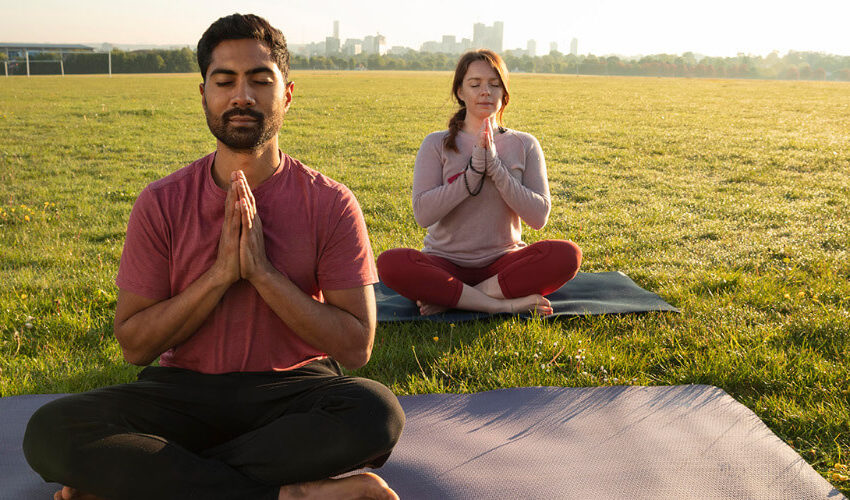
- February 10, 2024
- Meditation
In the pursuit of tranquility and improved well-being, wellness retreats have gained immense popularity. Guided meditation, an essential aspect of these retreats, plays a pivotal role in helping participants achieve profound relaxation and mental clarity.
Understanding Guided Meditation
Guided meditation is a structured form of meditation where an experienced instructor, often referred to as a guide or facilitator, leads participants through a carefully designed meditation practice. The guide’s soothing voice and carefully chosen words serve to direct the participants’ focus, guiding their thoughts, emotions, and sensations toward a specific intention or goal.
The Science Behind Guided Meditation
Guided meditation is firmly rooted in science and psychology. It leverages the brain’s neuroplasticity, the brain’s ability to reorganize and form new neural connections throughout life. The consistent practice of guided meditation can result in neurophysiological changes, leading to increased emotional regulation, reduced stress, and improved cognitive functions.
Research has shown that guided meditation can stimulate the brain’s anterior cingulate cortex and hippocampus, both of which are associated with attention, memory, and emotion regulation. Moreover, studies indicate that regular practice of guided meditation can increase the density of gray matter in brain regions related to self-awareness, compassion, and introspection.

The Benefits of Guided Meditation
Stress Reduction
In today’s fast-paced world, stress has become a prevalent issue affecting both physical and mental health. Guided meditation offers a potent remedy by activating the body’s relaxation response and calming the overactive stress response. By focusing on the present moment, participants can alleviate stress and anxiety, promoting a sense of peace and serenity.
Enhanced Self-Awareness
Self-awareness is the cornerstone of personal growth and development. Through guided meditation, individuals gain insight into their thoughts, emotions, and behavioral patterns. This heightened self-awareness empowers them to make positive changes, fostering emotional intelligence and overall well-being.
Improved Sleep Quality
Sleep is crucial for physical and mental restoration. Unfortunately, many people struggle with sleep-related issues. Guided meditation helps relax the mind and body, promoting better sleep quality by easing individuals into a state of relaxation conducive to restful slumber.
Heightened Concentration
In an increasingly distracted world, maintaining focus and concentration has become a challenge. Guided meditation exercises the mind’s focus muscles, enhancing cognitive abilities and concentration skills. With regular practice, individuals can sharpen their ability to sustain attention on tasks and achieve greater productivity.
Emotional Healing
Unresolved emotional traumas can hinder personal growth and contentment. Guided meditation aids in emotional healing by encouraging participants to acknowledge and release suppressed emotions in a safe and controlled environment. This process fosters emotional resilience and fosters a more positive outlook on life.

The Technical Aspects of Guided Meditation
Setting the Intention
Before delving into the meditation session, the guide helps participants set a clear intention for their practice. This intention serves as a compass throughout the meditation, allowing the participants to stay focused on their desired outcomes.
Breathwork Techniques
Conscious control of breath is an essential component of guided meditation. The guide instructs participants to engage in specific breathing techniques that help calm the nervous system and deepen their state of relaxation.
Visualization and Imagery
Guided meditation often incorporates visualization and imagery to enhance the meditation experience. Participants are encouraged to envision peaceful scenes, positive outcomes, or healing scenarios, amplifying the benefits of the practice.
Body Scanning
Body scanning involves directing the participants’ attention to different parts of their body, starting from the toes and gradually moving upward. This technique helps release tension and promotes a sense of bodily awareness.
Affirmations and Mantras
The guide may introduce affirmations or mantras during the meditation to encourage positive thinking and self-empowerment. Repeating these affirmations can rewire the brain with constructive thought patterns.
Integrating Guided Meditation in Your Wellness Retreat
The inclusion of guided meditation in a wellness retreat can significantly elevate the overall experience for participants. By incorporating this technical and scientifically proven practice, wellness retreat facilitators can offer attendees a comprehensive approach to achieve mental, emotional, and physical well-being.
Conclusion
Guided meditation is more than just a relaxation technique; it is a powerful tool that harnesses the mind’s potential for healing, growth, and self-awareness. Its technical aspects are deeply rooted in scientific research, making it a valuable addition to any wellness retreat program. Embrace the practice of guided meditation and unlock the path to inner peace and serenity.
